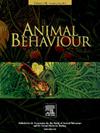迁移的东部横斑土拔鼠的逃跑行为与入侵掠食者有关,而与竞争对手无关
IF 2.3
2区 生物学
Q2 BEHAVIORAL SCIENCES
引用次数: 0
摘要
澳大利亚的哺乳动物灭绝记录是所有国家中最严重的,入侵的掠食者和竞争对手是主要的威胁过程。澳大利亚哺乳动物被认为表现出捕食者的天真,因为它们与真食肉动物的共同进化有限,因此抑制了它们的数量,阻碍了重新引入的努力。我们通过收集濒临灭绝的东部条纹土鼬(Perameles gunnii)种群中暴露于引入的捕食者(野猫,Felis catus)和竞争对手(欧洲兔,Oryctolagus cuniculus)的飞行起始距离(FIDs)和逃跑方向,对逃跑行为进行了指数化。猫和兔子同时存在的土拨鼠比只有兔子或既没有猫也没有兔子的地区的土拨鼠的FIDs更长。起跑距离越长,越有可能逃向掩体,而风的噪音可能会限制对接近的探测。这表明一些行为可塑性和细微差别,在土匪逃跑与捕食者有关,而不是竞争对手,可能是由于学习和/或选择。可能存在精通捕食者的土匪,这种行为可以在相对较短的时间内发展。这些个体很可能在有捕食者的环境中增加未来的迁移成功率。本文章由计算机程序翻译,如有差异,请以英文原文为准。
Escape behaviour of translocated eastern barred bandicoots differs in relation to invasive predators but not competitors
Australia has the worst mammal extinction record of any country, with invasive predators and competitors being key threatening processes. Australian mammals are thought to exhibit predator naivety due to limited coevolution with eutherian predators, which therefore suppress their abundance and hamper reintroduction efforts. We indexed escape behaviour by collecting flight-initiation distances (FIDs) and the orientation of escape across populations of the endangered eastern barred bandicoot, Perameles gunnii, exposed to an introduced predator (feral cats, Felis catus) and competitor (European rabbits, Oryctolagus cuniculus). Bandicoots in the presence of both cats and rabbits had longer FIDs than bandicoots in areas with rabbits only or with neither cats nor rabbits. Longer starting distances were associated with a greater likelihood of fleeing towards cover, and wind noise could potentially limit approach detection. This indicates some behavioural plasticity and nuance in bandicoot escapes associated with predators but not competitors, perhaps due to learning and/or selection. Predator-savvy bandicoots may exist, and this behaviour can develop over a relatively short time span. These individuals are likely to increase future translocation success in environments with predators.
求助全文
通过发布文献求助,成功后即可免费获取论文全文。
去求助
来源期刊

Animal Behaviour
生物-动物学
CiteScore
4.60
自引率
8.00%
发文量
236
审稿时长
10.2 weeks
期刊介绍:
Growing interest in behavioural biology and the international reputation of Animal Behaviour prompted an expansion to monthly publication in 1989. Animal Behaviour continues to be the journal of choice for biologists, ethologists, psychologists, physiologists, and veterinarians with an interest in the subject.
 求助内容:
求助内容: 应助结果提醒方式:
应助结果提醒方式:


